Abstract
1 The cellular electrophysiological effects of amiodarone and its metabolite desethylamiodarone (DEA) were studied in guinea-pig ventricular myocardium by use of standard microelectrode techniques. 2 Both compounds produced significant increases in action potential duration (Class III antiarrhythmic effect) and decreases in maximum rate of depolarization (Class I effect), at clinically relevant concentrations. 3 The Class I effects were rate-dependent, with small (0-16%) falls in maximum depolarization rate in the absence of stimulation ('resting block') and progressively larger effects at decreasing interstimulus intervals (range 1200-300 ms). 4 The kinetics of onset and offset of the Class I effect in response to a step change in driving rate were quite fast for both drugs (comparable to those reported for Class Ib agents). 5 It is concluded that this unique combination of Class III action plus Class I effects with fast onset and offset kinetics may help explain the great efficacy of amiodarone in antiarrhythmic therapy.
Full text
PDF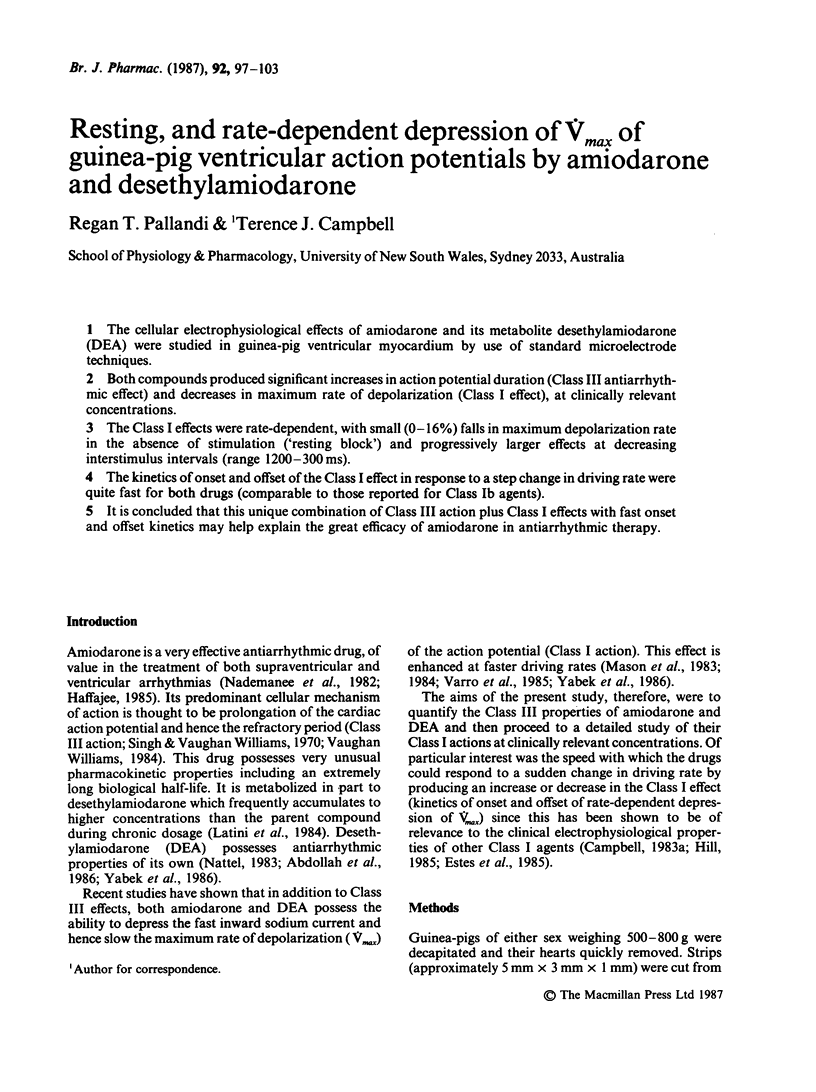
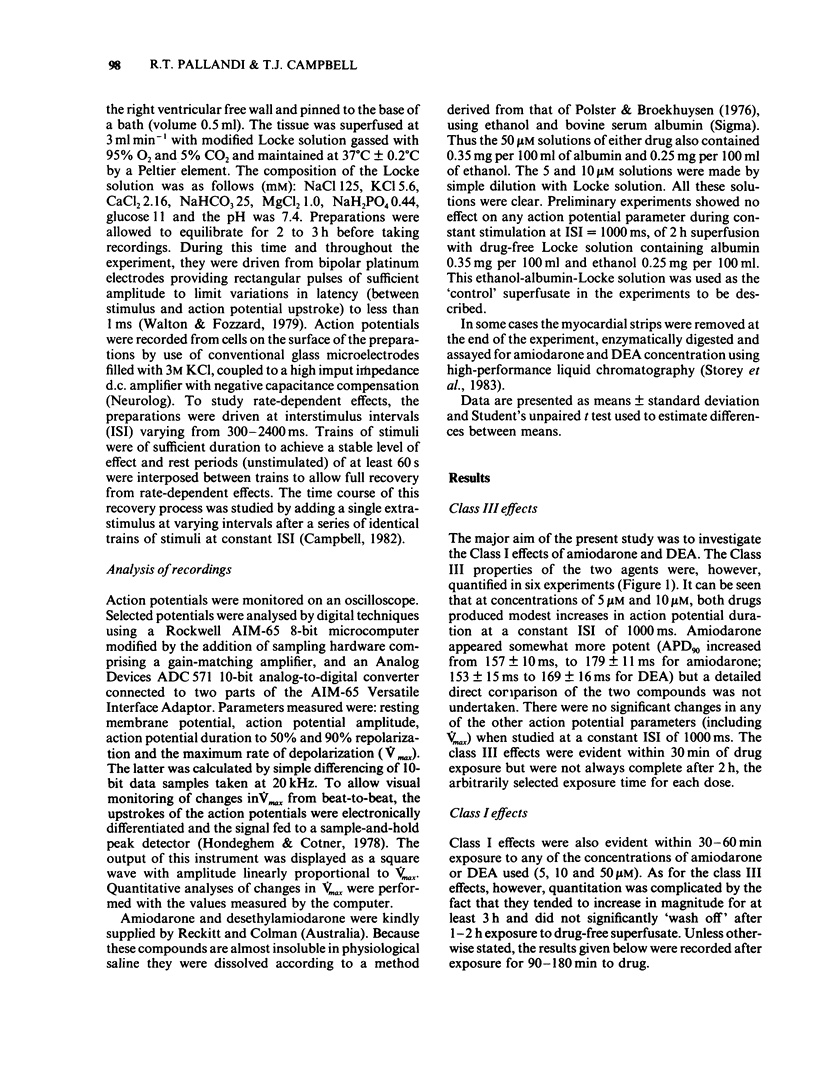

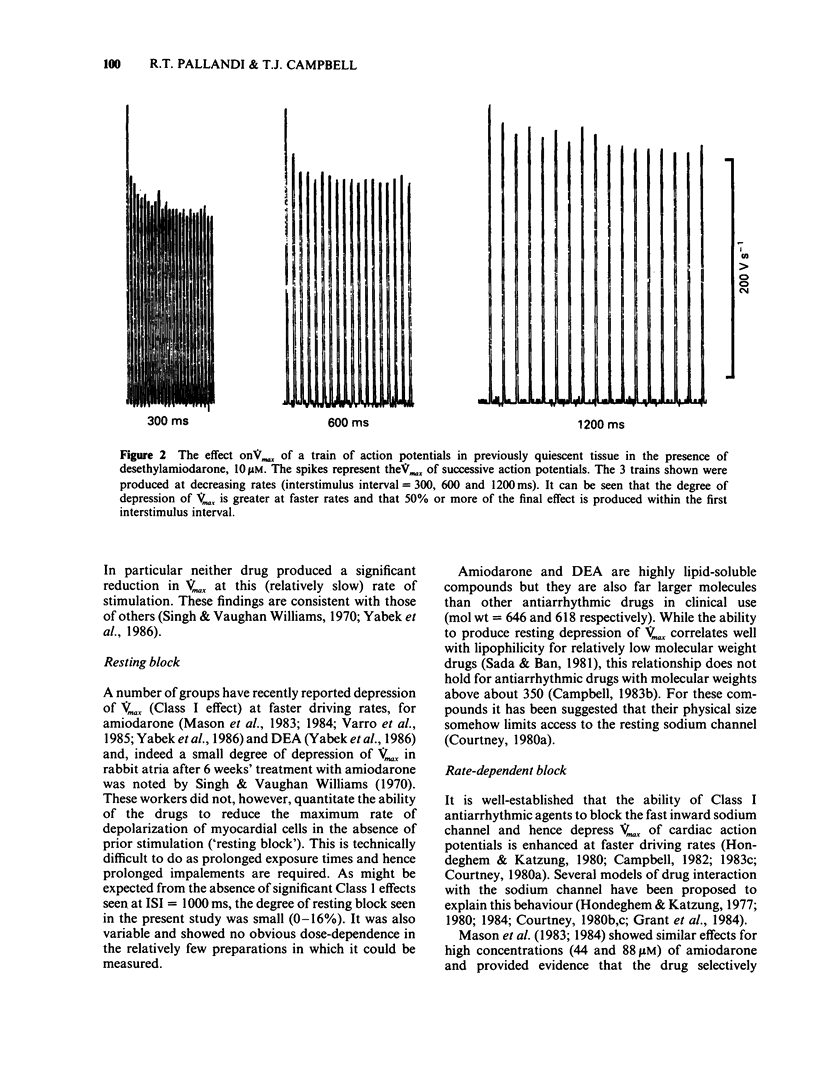
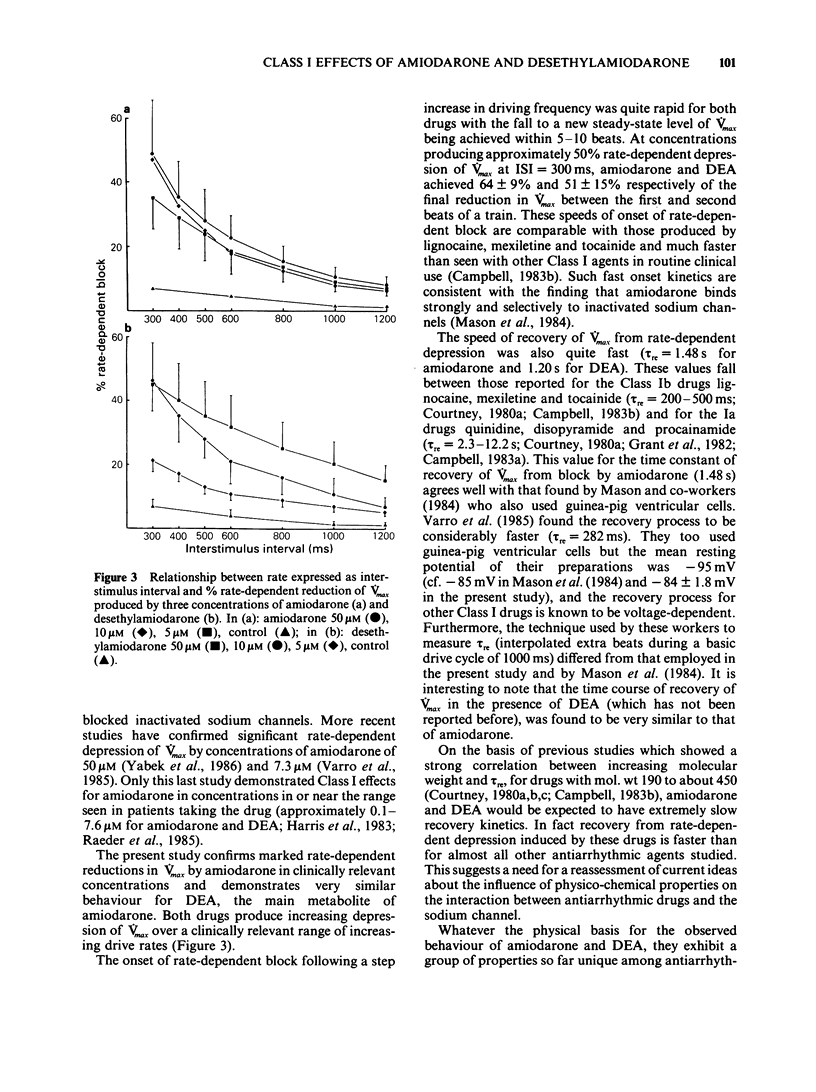
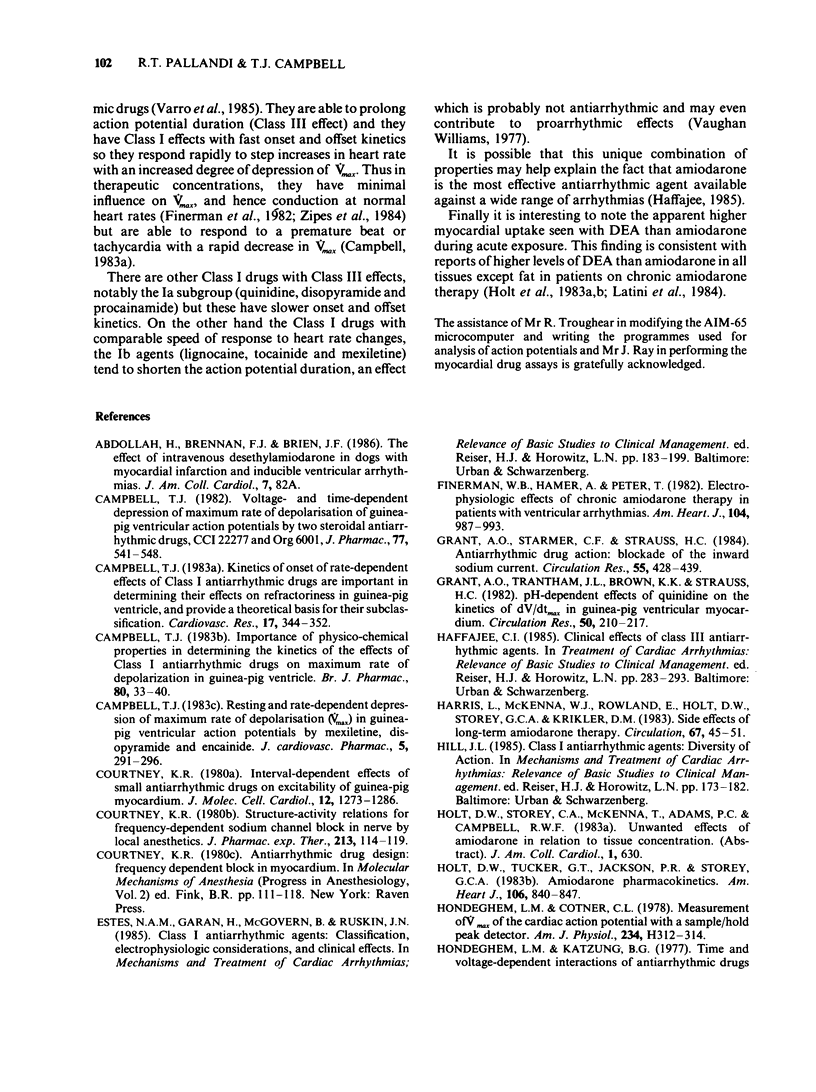
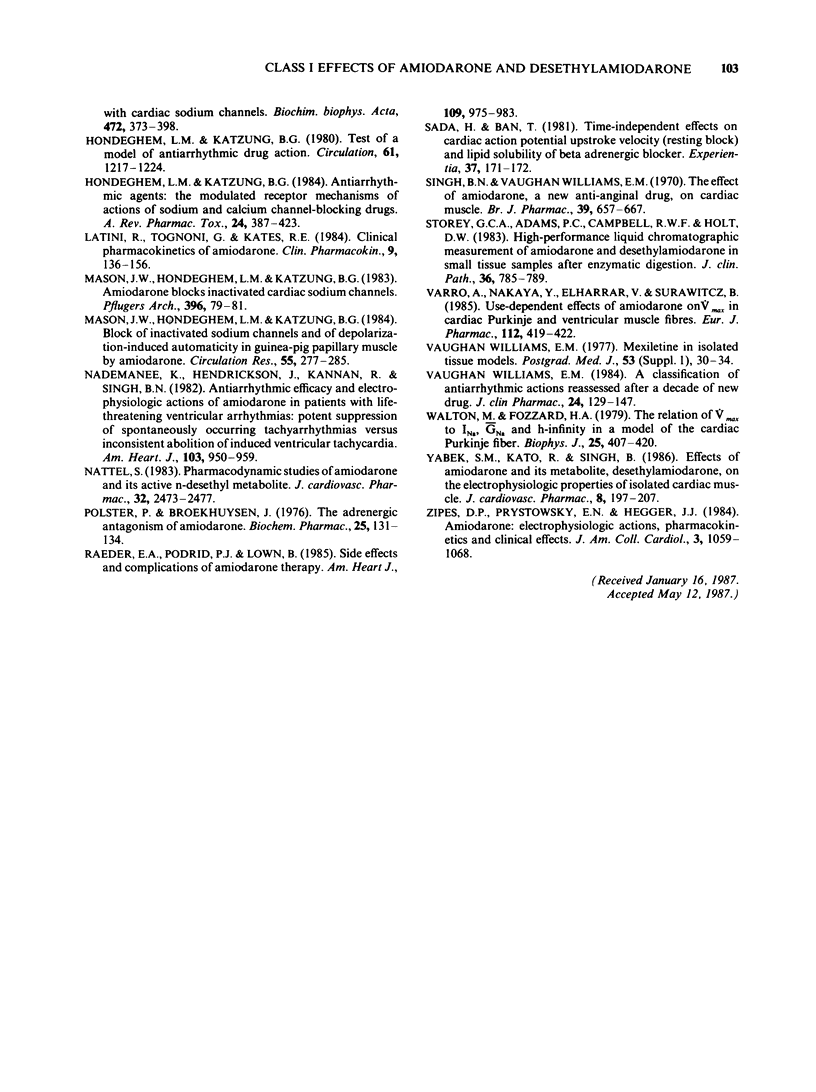
Selected References
These references are in PubMed. This may not be the complete list of references from this article.
- Campbell T. J. Importance of physico-chemical properties in determining the kinetics of the effects of Class I antiarrhythmic drugs on maximum rate of depolarization in guinea-pig ventricle. Br J Pharmacol. 1983 Sep;80(1):33–40. doi: 10.1111/j.1476-5381.1983.tb11046.x. [DOI] [PMC free article] [PubMed] [Google Scholar]
- Campbell T. J. Kinetics of onset of rate-dependent effects of Class I antiarrhythmic drugs are important in determining their effects on refractoriness in guinea-pig ventricle, and provide a theoretical basis for their subclassification. Cardiovasc Res. 1983 Jun;17(6):344–352. doi: 10.1093/cvr/17.6.344. [DOI] [PubMed] [Google Scholar]
- Campbell T. J. Voltage- and time-dependent depression of maximum rate of depolarization of guinea-pig ventricular action potentials by two steroidal antiarrhythmic drugs, CCI 22277 and ORG 6001. Br J Pharmacol. 1982 Nov;77(3):541–548. doi: 10.1111/j.1476-5381.1982.tb09329.x. [DOI] [PMC free article] [PubMed] [Google Scholar]
- Courtney K. R. Interval-dependent effects of small antiarrhythmic drugs on excitability of guinea-pig myocardium. J Mol Cell Cardiol. 1980 Nov;12(11):1273–1286. doi: 10.1016/0022-2828(80)90071-1. [DOI] [PubMed] [Google Scholar]
- Courtney K. R. Structure-activity relations for frequency-dependent sodium channel block in nerve by local anesthetics. J Pharmacol Exp Ther. 1980 Apr;213(1):114–119. [PubMed] [Google Scholar]
- Finerman W. B., Jr, Hamer A., Peter T., Weiss D., Mandel W. J. Electrophysiologic effects of chronic amiodarone therapy in patients with ventricular arrhythmias. Am Heart J. 1982 Nov;104(5 Pt 1):987–996. doi: 10.1016/0002-8703(82)90430-6. [DOI] [PubMed] [Google Scholar]
- Grant A. O., Starmer C. F., Strauss H. C. Antiarrhythmic drug action. Blockade of the inward sodium current. Circ Res. 1984 Oct;55(4):427–439. doi: 10.1161/01.res.55.4.427. [DOI] [PubMed] [Google Scholar]
- Grant A. O., Trantham J. L., Brown K. K., Strauss H. C. PH-Dependent effects of quinidine on the kinetics of dV/dtmax in guinea pig ventricular myocardium. Circ Res. 1982 Feb;50(2):210–217. doi: 10.1161/01.res.50.2.210. [DOI] [PubMed] [Google Scholar]
- Harris L., McKenna W. J., Rowland E., Holt D. W., Storey G. C., Krikler D. M. Side effects of long-term amiodarone therapy. Circulation. 1983 Jan;67(1):45–51. doi: 10.1161/01.cir.67.1.45. [DOI] [PubMed] [Google Scholar]
- Holt D. W., Tucker G. T., Jackson P. R., Storey G. C. Amiodarone pharmacokinetics. Am Heart J. 1983 Oct;106(4 Pt 2):840–847. doi: 10.1016/0002-8703(83)90006-6. [DOI] [PubMed] [Google Scholar]
- Hondeghem L. M., Cotner C. L. Measurement of Vmax of the cardiac action potential with a sample/hold peak detector. Am J Physiol. 1978 Mar;234(3):H312–H314. doi: 10.1152/ajpheart.1978.234.3.H312. [DOI] [PubMed] [Google Scholar]
- Hondeghem L. M., Katzung B. G. Antiarrhythmic agents: the modulated receptor mechanism of action of sodium and calcium channel-blocking drugs. Annu Rev Pharmacol Toxicol. 1984;24:387–423. doi: 10.1146/annurev.pa.24.040184.002131. [DOI] [PubMed] [Google Scholar]
- Hondeghem L. M., Katzung B. G. Time- and voltage-dependent interactions of antiarrhythmic drugs with cardiac sodium channels. Biochim Biophys Acta. 1977 Nov 14;472(3-4):373–398. doi: 10.1016/0304-4157(77)90003-x. [DOI] [PubMed] [Google Scholar]
- Hondeghem L., Katzung B. G. Test of a model of antiarrhythmic drug action. Effects of quinidine and lidocaine on myocardial conduction. Circulation. 1980 Jun;61(6):1217–1224. doi: 10.1161/01.cir.61.6.1217. [DOI] [PubMed] [Google Scholar]
- Latini R., Tognoni G., Kates R. E. Clinical pharmacokinetics of amiodarone. Clin Pharmacokinet. 1984 Mar-Apr;9(2):136–156. doi: 10.2165/00003088-198409020-00002. [DOI] [PubMed] [Google Scholar]
- Mason J. W., Hondeghem L. M., Katzung B. G. Amiodarone blocks inactivated cardiac sodium channels. Pflugers Arch. 1983 Jan;396(1):79–81. doi: 10.1007/BF00584702. [DOI] [PubMed] [Google Scholar]
- Mason J. W., Hondeghem L. M., Katzung B. G. Block of inactivated sodium channels and of depolarization-induced automaticity in guinea pig papillary muscle by amiodarone. Circ Res. 1984 Sep;55(3):278–285. doi: 10.1161/01.res.55.3.278. [DOI] [PubMed] [Google Scholar]
- Nademanee K., Hendrickson J., Kannan R., Singh B. N. Antiarrhythmic efficacy and electrophysiologic actions of amiodarone in patients with life-threatening ventricular arrhythmias: potent suppression of spontaneously occurring tachyarrhythmias versus inconsistent abolition of induced ventricular tachycardia. Am Heart J. 1982 Jun;103(6):950–959. doi: 10.1016/0002-8703(82)90556-7. [DOI] [PubMed] [Google Scholar]
- Polster P., Broekhuysen J. The adrenergic antagonism of amiodarone. Biochem Pharmacol. 1976 Jan 15;25(2):131–134. doi: 10.1016/0006-2952(76)90279-3. [DOI] [PubMed] [Google Scholar]
- Raeder E. A., Podrid P. J., Lown B. Side effects and complications of amiodarone therapy. Am Heart J. 1985 May;109(5 Pt 1):975–983. doi: 10.1016/0002-8703(85)90238-8. [DOI] [PubMed] [Google Scholar]
- Sada H., Ban T. Time-independent effects on cardiac action potential upstroke velocity (resting block) and lipid solubility of beta adrenergic blockers. Experientia. 1981 Feb 15;37(2):171–172. doi: 10.1007/BF01963214. [DOI] [PubMed] [Google Scholar]
- Singh B. N., Vaughan Williams E. M. The effect of amiodarone, a new anti-anginal drug, on cardiac muscle. Br J Pharmacol. 1970 Aug;39(4):657–667. doi: 10.1111/j.1476-5381.1970.tb09891.x. [DOI] [PMC free article] [PubMed] [Google Scholar]
- Storey G. C., Adams P. C., Campbell R. W., Holt D. W. High-performance liquid chromatographic measurement of amiodarone and desethylamiodarone in small tissue samples after enzymatic digestion. J Clin Pathol. 1983 Jul;36(7):785–789. doi: 10.1136/jcp.36.7.785. [DOI] [PMC free article] [PubMed] [Google Scholar]
- Varro A., Nakaya Y., Elharrar V., Surawicz B. Use-dependent effects of amiodarone on Vmax in cardiac Purkinje and ventricular muscle fibers. Eur J Pharmacol. 1985 Jun 19;112(3):419–422. doi: 10.1016/0014-2999(85)90791-5. [DOI] [PubMed] [Google Scholar]
- Vaughan Williams E. M. A classification of antiarrhythmic actions reassessed after a decade of new drugs. J Clin Pharmacol. 1984 Apr;24(4):129–147. doi: 10.1002/j.1552-4604.1984.tb01822.x. [DOI] [PubMed] [Google Scholar]
- Walton M., Fozzard H. A. The relation of Vmax to INa, GNa, and h infinity in a model of the cardiac Purkinje fiber. Biophys J. 1979 Mar;25(3):407–420. doi: 10.1016/S0006-3495(79)85312-6. [DOI] [PMC free article] [PubMed] [Google Scholar]
- Williams E. M. Mexiletine in isolated tissue models. Postgrad Med J. 1977;53 (Suppl 1):30–34. [PubMed] [Google Scholar]
- Yabek S. M., Kato R., Singh B. N. Effects of amiodarone and its metabolite, desethylamiodarone, on the electrophysiologic properties of isolated cardiac muscle. J Cardiovasc Pharmacol. 1986 Jan-Feb;8(1):197–207. doi: 10.1097/00005344-198601000-00029. [DOI] [PubMed] [Google Scholar]
- Zipes D. P., Prystowsky E. N., Heger J. J. Amiodarone: electrophysiologic actions, pharmacokinetics and clinical effects. J Am Coll Cardiol. 1984 Apr;3(4):1059–1071. doi: 10.1016/s0735-1097(84)80367-8. [DOI] [PubMed] [Google Scholar]


